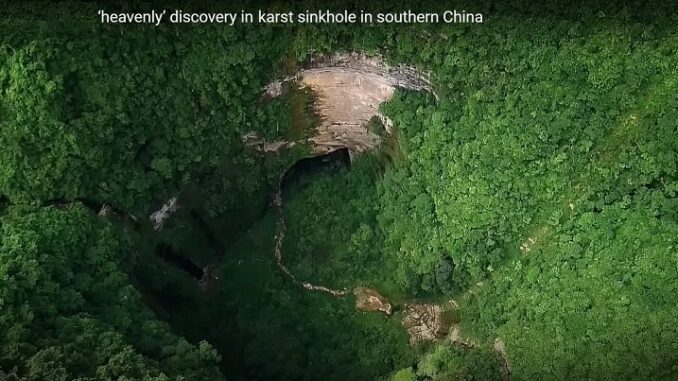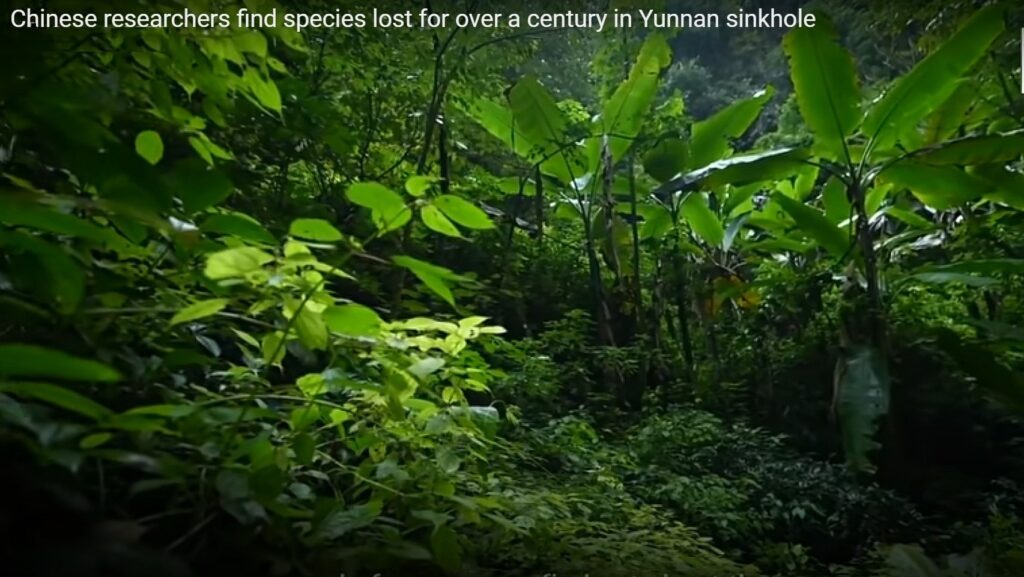
Primeval Forest Biodiversity Found in China’s Sinkholes
In the midst of southern China’s vast sinkhole-ridden landscape, a recent study of ancient forests found growing in the depths of karst tiankengs – super-deep sinkholes – has revealed the astonishing degree of biodiversity they harbor and protect.
Rather than representing a simple extension of surrounding above-ground ecosystems, these lush forests, which are partially hidden hundreds of feet beneath the earth’s surface inside the tiankengs, are unique. While the species they host are recognizable, they are also different in some fundamental ways, as they have preserved a mixture of DNA that is more complex and diverse than what can be found in their cousins that grow at the surface level.
Karst Tiankengs preserving DNA from dinosaur era
In a new article just published in the peer-reviewed journal Forests, a team of Chinese botanists and plant geneticists introduced the results of their study of the genetic diversity of a rare species of tree that grows in southern China, both inside sinkholes and around them in the region’s rugged karst terrain. This tree is known as the Manglietia aromatica, and while it is considered nearly extinct above the ground it can still be found growing wild and in abundance inside China’s massive sinkholes.

Tiankeng, or giant karst sinkhole, at Leye-Fengshan Global Geopark, south China’s Guangxi Zhuang Autonomous Region. (Xinhua/Zhou Hua)
‘Tiankeng’ is Mandarin for ‘heavenly pits,’ and those that were explored for the purposes of this new study can be found in southern China’s Guangxi Zhuang Autonomous Region, which like all karst landscapes features porous limestone rock that can easily be eroded away by rainfall and rainfall runoff. In the Guangxi region the rock is so porous that giant sinkholes have been created over time, which are essentially giant caves that experienced a collapse of their rock ceilings.
The Guangxi Zhuang Autonomous Region borders Vietnam and is a designated UNESCO World Heritage Site. The area is known for its stalactites and stalagmite riddled caves, charging rivers, and towering tooth-like karst formations – and countless sinkholes. According to the Xinhua news agency this south China sinkhole is 192 meters deep and the interior measures 306 meters long and 150 meters wide. This is about half the depth of the deepest water-filled sinkhole on the planet, the El Zacatón sinkhole in northeast Mexico, which is 335 meters deep.
Approximately 30% of the world’s known ‘heavenly pits’ are found in this specific area, and two-thirds of the world’s known 300 tiankengs are located somewhere China. Scientists have been concentrating their research on a set of adjacent sinkholes in Guangxi territory known as the Dashiwei Tiankeng Group, which includes 29 tiankengs distributed over an area of just 20 square kilometers.

Xiaozhai “Tiankeng” (collapse of a river cave roof), seen from the southern rim; in Chongqing
For scientists this area functions as an incredibly fertile biological and genetic laboratory, where they can study the effects of isolation and evolution on protected ecosystems that are vertically separated from those that exist at ground level. The giant sinkholes of the Dashwei Group are teeming with plant and animal life, like gigantic terrariums made by nature rather than by humans.
For scientists this area functions as an incredibly fertile biological and genetic laboratory, where they can study the effects of isolation and evolution on protected ecosystems that are vertically separated from those that exist at ground level. The giant sinkholes of the Dashwei Group are teeming with plant and animal life, like gigantic terrariums made by nature rather than by humans.
Tiang Jianmin, a botanist from the Guangxi Institute of Botany and co-author of the newly published study, described the experience of rappelling down to the bottom of one of the Guangxi region’s humongous sinkholes for the first time.
“The scene down there was stunning: an underground pristine forest with no trace of human activities, with 40-meter-high ancient trees and a group of endangered wild plants from the times of dinosaurs,” he stated, in an article he wrote for the UNESCO Courier in 2023.
Exploring the flora of Tiankengs
In the study that was just published in Forests, Tang Jianmin and his colleagues from the Guangxi Institute of Botany and the South China Botanical Garden explained how they used ultra-sensitive Hyper-seq gene sequencing technology to analyze the DNA of Manglietia aromatica trees growing inside karst tiankengs. They chose this species in particular because it thrives and has proliferated inside the sinkholes, while having gone nearly extinct at the surface level.
Using these advanced techniques for genetic study, the scientists confirmed that the genetic diversity of the Manglietia aromatica populations in the sinkholes was significantly higher than for populations of the trees found elsewhere. Measured on a genetic diversity index, the sinkhole trees were found to be about 23% more genetical diverse than their surface-level cousins, which is a big number given the proximity of the two species in terms of space (they were growing very close to each other, but still diverged quite sharply in their evolution).
Based on these findings, the Chinese researchers are calling for the protection of the karst tiankeng ecosystems, which they believe is necessary to preserve a rich pool of DNA that could help increase rare or endangered species’ chances of survival. In a 2022 survey a team of botanists discovered 22 species of endangered wild plants growing in sinkholes in the Dashiwei Tiankeng Group, which highlights how useful the tiankengs could be as repositories of genetic diversity that would otherwise be lost forever.

The need to protect endangered biological diversity
The karst tiankengs of southern China are currently diverse and fertile,but human activities present a potential long-term threat to the health of these unusual and valuable ecosystems. The Chinese scientists involved in this new study are hopeful their work will contribute to making conservation planning for these ecosystems easier and more effective.
“By revealing the plant’s mating system patterns and spatial variation rules, its evolutionary history and the changes in its geographical distribution in response to climate and geological environment changes, our study provides a scientific basis for effective protection,” Jianmin explained.
He noted that right now the main threats to the karst tiankengs forests in southern China are eco-tourism, which can be destructive, and the diversion of the groundwater that sustains the forests for irrigation and other human uses. He also acknowledged that the plant resources found inside the sinkholes are being harvested by people to some extent, and this is an activity that will have to be carefully monitored (along with levels of water usage and tourism) in the years ahead to ensure the tiankeng ecosystems’ survival.
Source: Ancient Origins, 6 May, 2024. https://www.ancient-origins.net/news-general/china-sinkhole-forests-biodiversity-0020750 [Author: Nathan Falde]
Video source: New China TV, May 8, 2022. https://youtu.be/nKsH9BRJ1oU